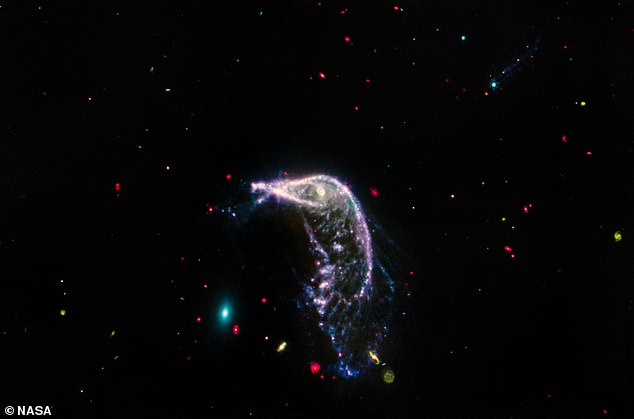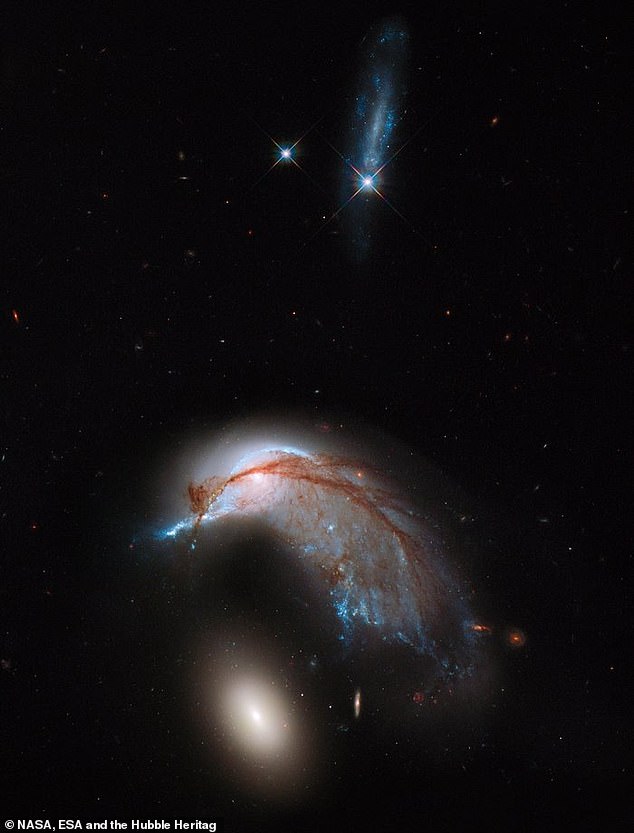NASA’s James Webb captures two merging galaxies, creating an image of one of Earth’s most beloved animals… DO YOU SEE it?
NASA has just released the most beautiful image yet from the James Webb Space Telescope.
The US space agency shared an image of what appears to be a penguin and an egg, about 326 million light-years away from Earth.
But the telescope actually captured two galaxies, known as ARP 142, connected by a blue haze of stars and gas.
Their interaction began between 25 and 75 million years ago, when the penguin (originally named NGC 2936) and the egg (NGC 2937) first passed each other.
The orange spiral galaxy in the center has been distorted into the shape of a penguin by its interaction with the white elliptical galaxy on the left, which resembles an egg.
Webb is considered the most powerful telescope ever launched into space. It specializes in capturing infrared light, which allowed him to photograph these two galaxies in stunning detail.
“In just two years, Webb has changed our view of the universe and enabled the kind of world-class science that drove NASA to pursue this mission,” said Mark Clampin, director of the Astrophysics Division at NASA Headquarters, in a press release.
On Friday, two years after NASA presented the first space images of Webb, the space agency released a new near- and mid-infrared image of the two interacting galaxies.
Webb observes infrared light using a combination of two instruments: the Near-Infrared Camera (NIRCam) and the Mid-Infrared Instrument (MIRI).
NIRCam detects light from the earliest stars and galaxies in their formation process, the population of stars in nearby galaxies, and young stars in the Milky Way and Kuiper Belt objects.
Webb’s MIRI features both a camera and a spectrograph, which separates the incoming light by frequency and records the resulting spectrum.
MIRI also has sensitive detectors that allow it to observe red-shifted light from distant galaxies, newly formed stars and faint comets, as well as objects in the Kuiper Belt.

In this mid-infrared image of the Penguin and Egg galaxy, the egg is seen in bright green and the penguin in pink and purple.
This allows scientists to see cosmic objects invisible to the human eye, leading to a number of groundbreaking discoveries.
In the two years since its launch, Webb has imaged the oldest known galaxies in the universe, previously unseen stages of star formation, and much more.
This new image is another example of Webb’s infrared detection capabilities.
Before the galaxies merged, the penguin had the shape of an average spiral galaxy, rich in gas and dust.
But the egg’s gravity caused its shape to distort.
Now its center glitters like an eye and its galactic arms form the shape of a beak, head, spine and tail.
The interaction between these two galaxies has tugged on the penguin’s inner regions, which consist of thin gas and dust, causing these regions to condense and form new stars.
This can be seen from the ‘fish’ the penguin holds in its beak and from the ‘feathers’ on its tail, according to NASA.
The shape of the egg has remained largely unchanged since then.

The two galaxies were first imaged by the Hubble Telescope in 2013 (pictured)
That’s partly because it’s an elliptical galaxy, meaning it’s full of aging stars and has less gas and dust to pull in by external gravitational forces. If both were spiral galaxies, this unique picture wouldn’t have formed.
In the upper right corner of Webb’s snapshot, another galaxy can be seen bombarding the image.
This galaxy, called PGC 1237172, is located about 100 million light-years closer to Earth.
Webb was looking at it from the side, which is what gives it a side view.
And it is filled with young stars, which sparkle bright blue in the image.
In the background, Webbs’ image is dotted with even more distant galaxies, demonstrating the sensitivity and high resolution of Webbs’ infrared instruments, NASA said.
Although the penguin and the egg are engaged in a cosmic dance, they are still about 100,000 light years apart. On a cosmological scale, that is quite close.
Eventually they will merge into one galaxy, but that will take hundreds of millions of years.
In the meantime, Webb continues to explore and document the farthest reaches of the universe.
